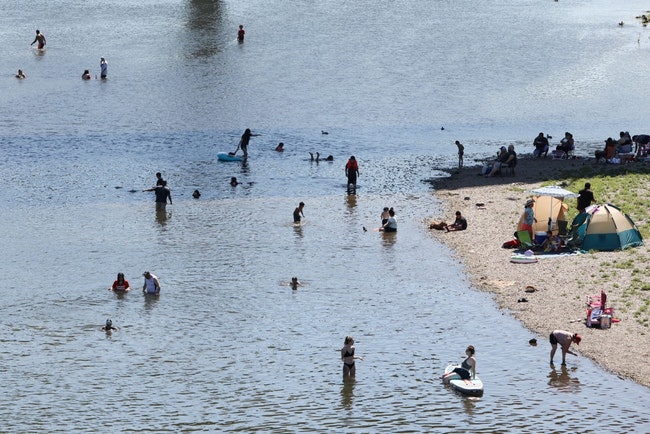
People cool off in the Willamette River at Wallace Marine Park on Saturday, June 26. (Amanda Loman/Salem Reporter)
Salem residents this weekend can expect the first significant rainfall since January in a year that’s so far recorded hotter temperatures and less precipitation than normal.
The city is expected to have between a half-inch and three quarters of an inch of rain both Friday night and Saturday, according to the National Weather Service.
The agency forecasted showers to continue to Sunday and likely Sunday night, with possible thunderstorms Saturday through Sunday and a chance of more rain Monday.
This weekend’s rain forecast comes on the heels of a summer that shattered Salem’s temperature record during the June heat wave, reaching a historic 117 degrees on June 28.
January 12 marked the last time Salem had more than an inch of rain on a given day, with 1.93 inches of rain, said Jon Bonk, a meteorologist for the National Weather Service in Portland.
Bonk said this past June through August was the warmest summer in the agency’s 130 years of recorded data. The three-month period saw an average temperature of 71.7 degrees, just slightly above the previous record of 71.3 degrees held by the same timeframe in 2015.
(Graphic by Rachel Alexander/Salem Reporter)
The key difference for this summer, he said, was a “persistent, high-pressure ridge” that sat over the Pacific Northwest or just offshore. Ridges create a stagnant area where hot air is trapped in the atmosphere and blocked from escaping, which leads to hotter temperatures on the ground.
Oregon is becoming warmer during all seasons – particularly during summer – with both the number of hot days and the temperatures on hot days increasing, said Erica Fleishman, director of the Oregon Climate Change Research Institute at Oregon State University.
Fleishman said in an email that the June heat wave “was fairly extreme even given climate change.” But recent research, she said, suggests that if current levels of greenhouse gas emissions continue, a similarly extreme heat wave may occur about every five to ten years by mid-century.
State climatologist Larry O’Neill said future projections indicate Salem will see similar hot and dry summers progressively more often, “even if not every single one will necessarily be this intense.” People can expect more days with 90-plus degree temperatures, warmer overnight low temperatures, occasional extreme heat episodes like the June heatwave, longer summers and shorter winters, and “somewhat less precipitation,” O’Neill said in an email.
A month after Oregon’s June heat wave that killed at least four people in Marion County and one in Polk County, the state Office of Emergency Management said better preparation for the extreme temperatures could have saved lives.
The agency in its after-action report issued recommendations for the state to more effectively respond to extreme heat, which included sharing more health information with state leadership, eliminating fees for public transportation during extreme weather events and providing 24/7 access to 211, a nonprofit call line that connects people to cooling centers and other resources.
This weekend’s forecasted rain also comes eight months into an ongoing, statewide drought, which he said “has been unusually severe” and is following a pattern of drought periods becoming drier and more intense over time due to changing climate.
Oregon has continued to lack precipitation and see periods of increasing temperatures since around 2000. O’Neill said 17 out of the state’s last 21 water seasons, including this year, have been drier than normal, and the persistent water deficit year over year increases the severity of droughts over time.
O’Neill said annual precipitation amounts are expected to increase slightly in the future, but projections also indicate more of that water will evaporate from the landscape. The result is less total water availability, which he said will negatively affect forests, agricultural and livestock production, groundwater and river, lake and stream levels.
“By most indications, this drought is as severe as the most severe droughts in our recorded history,” O’Neill said.
He said his main concerns are related to the adverse impacts already seen from the drought, which include extreme fire risk, decreased water quality and diminished quality of fish, wildlife and plant habitat.
“The severity of the impacts we are observing now is a consequence of the relative severity of this drought compared with typical droughts experienced historically in the Pacific Northwest,” O’Neill said.
Contact reporter Ardeshir Tabrizian: [email protected] or 503-929-3053.
JUST THE FACTS, FOR SALEM – We report on your community with care and depth, fairness and accuracy. Get local news that matters to you. Subscribe to Salem Reporter starting at $5 a month. Click I want to subscribe!









